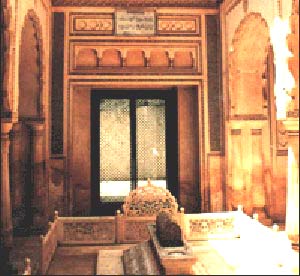»
Tourist Spots » Paigah PalacePaigah Palace

Aishwarya Subramanyam / fullhyd.com
You've got to hand it to the architects of old. They anticipated Hyderabad's extreme weather conditions and built around them. In the HUDA (Hyderabad Urban Development Authority) office, no one complains about the intense heat at the peak of summer, even though they have no air conditioning or coolers. Employees may collapse from the heat on their way to work, but once they're inside the building, they only collapse from inactivity. (We are of course kidding. We value government employees very highly. Very.)
This is because the Paigah Palace, where they work, is a marvel of architectural design, with high ceilings, massive rooms and thick walls to keep out the heat, not to mention cunning ventilation that allows air to circulate freely. This huge palace has a neo-classical facade, a grand portico with entablature, semi-circular arches, Corinthian columns and deep, arcaded verandas on all four sides. I have no idea what that means. But you don't need to know architectural styles to appreciate beauty in stone or to wonder at carefully carved wooden staircases. Office mundanities and irrelevant furniture nonwithstanding.
The palace was built by Vicar-Ul-Umara, the Paigah noble who is famous for having built the Falaknuma Palace. He was Prime Minister when he handed over the Falaknuma at the behest of the sixth Nizam, Mir Mahbub Ali Khan. He then built the Paigah Palace, also known as the Devdi Iqbal-ud-Daula, in the 1880s, along with a number of others on his 150-acre stretch of land. The Paigahs were the highest-ranking nobles at that time, second only to the ruling family.
The HUDA shifted here in 1981, and added a four-storeyed modern annexe building unobtrusively to the back of the palace in 1999, trying to keep basic styling intact. The compound is still full of trees, one of which apparently still attracts migratory birds, and an old well still supplies water. This is heartening.
This is because the Paigah Palace, where they work, is a marvel of architectural design, with high ceilings, massive rooms and thick walls to keep out the heat, not to mention cunning ventilation that allows air to circulate freely. This huge palace has a neo-classical facade, a grand portico with entablature, semi-circular arches, Corinthian columns and deep, arcaded verandas on all four sides. I have no idea what that means. But you don't need to know architectural styles to appreciate beauty in stone or to wonder at carefully carved wooden staircases. Office mundanities and irrelevant furniture nonwithstanding.
The palace was built by Vicar-Ul-Umara, the Paigah noble who is famous for having built the Falaknuma Palace. He was Prime Minister when he handed over the Falaknuma at the behest of the sixth Nizam, Mir Mahbub Ali Khan. He then built the Paigah Palace, also known as the Devdi Iqbal-ud-Daula, in the 1880s, along with a number of others on his 150-acre stretch of land. The Paigahs were the highest-ranking nobles at that time, second only to the ruling family.
The HUDA shifted here in 1981, and added a four-storeyed modern annexe building unobtrusively to the back of the palace in 1999, trying to keep basic styling intact. The compound is still full of trees, one of which apparently still attracts migratory birds, and an old well still supplies water. This is heartening.
PAIGAH PALACE SNAPSHOT
-
Listed InLandmarks / Tourist Spots1 user says this is wrong.
-
Address
-
Telephone
-
Distance1.3 km (Maps & Directions)1 user says this is wrong.
-
Year Started
-
Timings
-
Closed On
-
Closest Bus Stop
-
Closest MMTS Station
-
Add New Field:
EVENTS AT PAIGAH PALACE
There are no events at Paigah Palace scheduled currently.
PAIGAH PALACE USER REVIEWS
2 USERS
Quality
Service/Courteousness
Value For Money
7.5
6.5
6.5
Be the first to comment on Paigah Palace! Just use the simple form below.
LEAVE A COMMENT
fullhyd.com has 700,000+ monthly visits. Tell Hyderabad what you feel about Paigah Palace!
RELATED LISTINGS
Golconda (7.3km)
Near Clock Tower, 43, Sarojini Devi Road, S D Road (6.4km)
Lower Tank Bund, Opposite To Ramakrishna Math, Nr Bandamaisamma Nagar, Lower Tankbund (2.5km)
5-8-330, Chapel Road, Abids (0.5km)
Charminar (3.5km)
RELATED CATEGORIES
SEARCH YELLOW PAGES
Dissatisfied with the results? Report a problem or error, or add a listing.